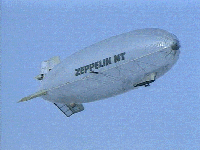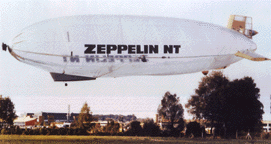NT (New Technology)
News: since 1997 > Visit the Zeppelin
NT website.
News: 1995-1997 > See below
18 September 1997
The Zeppelin NT made its first flight
at 18:45, Friedrichshafen time.
1996: Zeppelin NT to grow in size
From: Eric Brothers
A reliable report out of Germany last week says that the Zeppelin
NT is growing by 6.5 meters to an approximate length of 75m. Through
this, the approx. volume is increasing from 7,200 cu. m. to 8,200 cu.
m. The larger dimensions are achieved through an additional cylindrical
element near the airship's maximum girth.
The official report explains the addition is being made in response
to end-users' needs for greater payload capacity and for sufficient
fuel reserves for longer flights.
There will be no need for additional type approval, which is being
accomplished under the current prototype status.
The enlarged airship is still scheduled to make its debut at AERO
97 next spring. When weather conditions permit, the airship is to
be flown from its construction site to a mast at the Friedrichshafen
airport (in nearby Lowenthal) from where test flights will begin.
The airship's envelope, made by ILC-Dover, is already at Friedrichshafen.
An additional connecting piece is being fabricated to cover the ship's
lengthened mid section. This will be installed on site in the manner
previously devised for connecting the fore and aft sections of envelope
over the rigid framework.

1996: Zeppelin NT
From: Jacob Munkhammar
From the German quarterly magazine "FORM - Zeitschrift für
Gestaltung", issue 154/155, 2/3 1996. Written by Armin Scharf.:
"From next year on, there will be a new roar in the sky. For from
1997 onwards a Zeppelin will once again float through the air, bringing
back to life a principle regarded dead for around 60 years. But only
the name, the principle of the frame for rigidity and the overall
shape of the "Zeppelin NT" are reminiscent of its huge ancestors which
once flew half way around the globe. The technology, materials and
construction of the "NT" in contrast are highly modern - and promise
to make the airship an interesting, environmentally friendly and spectacular
aircraft of the future. A first glance at the as yet "unwrapped" ship
is available from 2nd July - then, namely, the new Zeppelin museum
will be opened at the Friedrichshafen port after many years conversion
work. The special highlight of the museum: an accurate reconstruction
of a segment of the LZ 129 "Hindenburg" which crashed in 1937. More
about the Zeppelin in the next form."
27 July 1995
VideoActiv@aol.com / Don Campbell:
The first of three presentations from Zeppelin Luftschfftecknik
focused on their experience gaining compliance to FAA and German air
administration rules and regs fro airships. This presentation offered
the closest thing to an overall design review of the projected LZ NT
(New Technology) airship series. One of the design goals of the Zepp
ship is to eliminate the need for a ballast system, this placed new
considerations to the existing certification process, encouraging Zeppelin
and the German authorities to develop a new set of criteria for certification
of their ship.
The first of the new Zeppelins to be built, the LZ N07 will be a
full scale prototype of the company's innovative semi-ridig approach
to modern airship design. The N07 envelope is built around a triangular
structural frame, inscribed within the circumference of the hull fabric.
3 horizontal spars or longerons run the entire length of the envelope
connecting the vertices of the 11 vertical triangular trusses, which
are also supported by other internal cross-bracing. All of the dirigible's
control surfaces and propulsion units as well as the gondola are supported
by the ships rigid frame.
Helium is contained within the envelop in three separate cells. Overall
displacement is listed at 7,200 cubic meters for a gross lift of 6,950
kg. Zeppelin projects a a payload capacity of 1,850 kg, and the gondola
will carry 14; 2 crew and up to 12 passengers.
Two forward propellors vectorable to 120 degrees and with reversible
pitch control. In the after, a single engine drives two props, a large
vectorable fan facing to the rear or straight down, and a smaller
prop horizontally mounted at ninety degrees to the centerline.

|

